On a metropolitan area network, VIP customers access the network through the MPLS VPN to ensure their security. Which of the following security deployments are required for PEs?
The Huawei router is the last hop DR where the SSM Mapping function is enabled at the interface.
Some IGMPv2 hosts expect to receive (1.0.0.1, 232.1.0.1), (1.0.0.1, 232.1.0.2), and (2.0.0.1,
232.1.3.2) data. How can you satisfy the preceding requirements with the least configurations?
Refer to the exhibit.
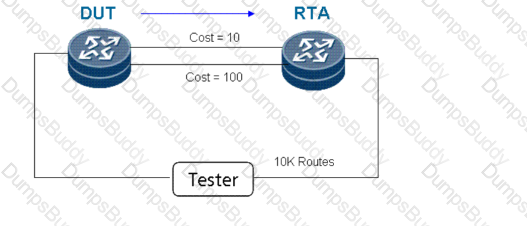
As shown in the figure, DUT stands for the device under test and RTA is
used to support the test.What is the correct procedure of a fast convergence test? ( )
1. Read data from the tester, record the numbers of sent and received packets, and count the
number of lost packets.2. Switch the DUT-to-RTA background traffic to the link whose metric value
is 100.3. DUT-to-RTA background traffic is forwarded along the link whose metric value is 10.4. Use
the tester to advertise 10K routes to RTA and inject 10K flows to the DUT (each flow takes one
route).5. Remove the optical fiber (providing a link whose metric value is 10) from the tester.6.
Calculate the convergence time based on the number of lost packets and packet sending rate.7.
Stop forwarding traffic when the packet receiving rate is equal to the packet sending rate.
On the IP bearer network, different VPN users (VPN A and VPN B) must access the internet through the same egress. Which of the following schemes can achieve security isolation VPNs and have the best scalability?
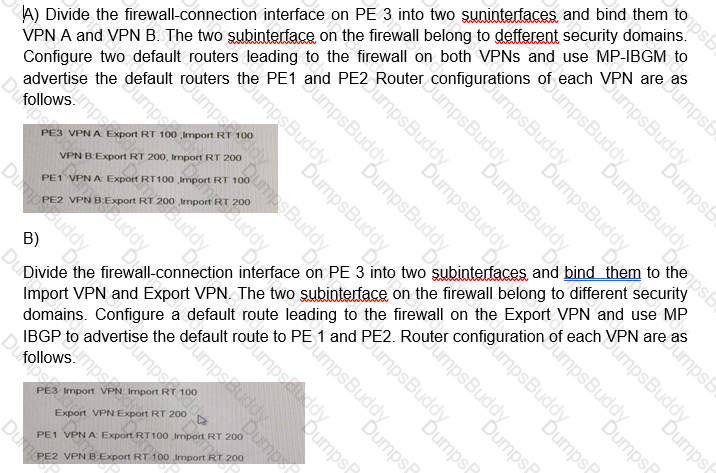
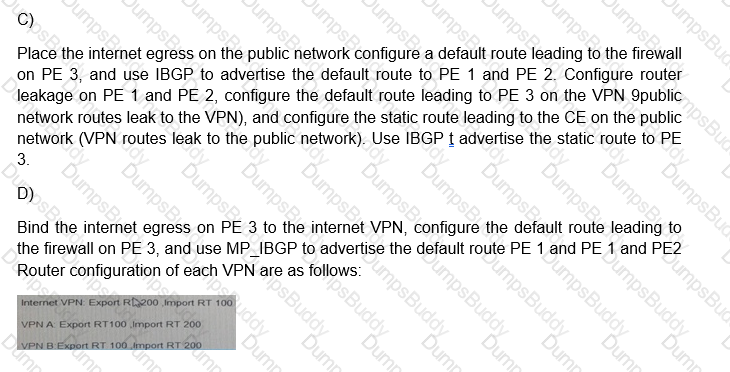
Which statement about the configuration of route target (RT) and route distinguisher (RD) is true?
RTA is a leaf router that directly connects to host A through interface GigabitEthernet 1/0/0. The
interface is configured as follows:
interface GigabitEthernet1/0/0
undo shutdown
ip address 192.168.4.2 255.255.255.0
pim sm
igmp enable
igmp version 3igmp ssm-mapping enable
igmp static-group 232.1.1.1
Configurations in the IGMP view are as follows:
igmp
ssm-mapping 232.1.1.0 255.255.255.0 10.10.1.1
ssm-mapping 232.1.2.0 255.255.255.0 10.10.1.1
Host A sends an IGMPv2 Report message to group 232.1.2.2. Which entry can be displayed by the
display igmp ssm-mapping group command?
User A wants to obtain a better network service for business development and signs an SLA with a carrier. User A purchases a bandwidth of 5 Mbit/s to ensure the voice service (requiring short delay), video service, key data services, and other services. If you were the carrier’s network administrator, what would you do on the PE to ensure these services?
When the multicast source starts to send multicast data and no receiver joins in the RP in PIM-SM, which of the following statements are true?
Which of the following methods can be used to ensure loop-free and reachable Martini VPLS links?
#
interface Ethernet6/1/1
ip address 40.1.1.4 255.255.255.0
igmp prompt-leaveigmp enable
pim sm
#
IGMP interface group report information of VPN-Instance: public net
Ethernet6/1/1(40.1.1.4):
Total 1 IGMP Group reported
Group: 224.1.2.3
Uptime: 00:00:32
Expires: 00:04:38
Last reporter: 30.1.1.30
Last-member-query-counter: 0
Last-member-query-timer-expiry: off
Version1-host-present-timer-expiry: off
The preceding information shows the configurations of Ethernet 6/1/1 and entries created based on received IGMPv2 Report messages. Which action does Ethernet 6/1/1 perform after receiving Leave messages for group 224.1.2.3?
Refer to the exhibit.

As shown in the figure, a CE requires access to the Internet, and PE 1 is
connected to the Internet gateway. Configurations on PE 1 are as follows:
PE 1:
#
nat address-group 0 175.31.1.3 175.31.1.10
#
ip vpn-instance vrf1route-distinguisher 192.168.1.1:100
vpn-target 100:1 export-extcommunity
vpn-target 100:1 import-extcommunity
#
acl number 2000
rule 5 permit vpn-instance vrf1
#
#
interface Serial0/0/1:0
link-protocol ppp
ip binding vpn-instance vrf1
ip address 150.1.1.1 255.255.0.0
nat outbound acl 2000 address-group 0
#
interface Pos2/1/0
clock master
link-protocol ppp
ip address 175.31.1.1 255.255.0.0
#
bgp 100
group ibgp internal
peer ibgp connect-interface LoopBack0peer 192.168.1.2 as-number 100
peer 192.168.1.2 group ibgp
#
ipv4-family unicast
undo synchronization
peer ibgp enable
peer 192.168.1.2 enable
peer 192.168.1.2 group ibgp
#
ipv4-family vpnv4
policy vpn-target
peer ibgp enable
peer 192.168.1.2 enable
peer 192.168.1.2 group ibgp
#
ipv4-family vpn-instance vrf1
default-route imported
import-route direct
import-route static
group nei_vrf1 external
peer nei_vrf1 as-number 65004
peer 150.1.1.2 as-number 65004peer 150.1.1.2 group nei_vrf1
#
ip route-static vpn-instance vrf1 0.0.0.0 0.0.0.0 175.31.1.2
PE 1 is connected to the Internet gateway through interface 175.31.1.2. CE 1 and CE 2 cannot ping
this interface. Which of the following statements are true?
As shown in the figure, a CE requires access to the internet , and PE 1is connected to the gateway. Configurations on PE 1 are as follows:

PE 1 is connected to the internet gateway through interface 175.311.2 CE and CE 2 cannot ping the interface. Which of the following statements are true?
Configurations are as follows:
#
multicast routing-enable
#
msdp
peer 2.2.2.2 connect-interface loopback0
peer 3.3.3.3 connect-interface loopback0
import-source acl 3000
peer 2.2.2.2 sa--policy import acl 3001
peer 3.3.3.3 sa--policy export acl 3002
#
Interface loopback0
ip address 1.1.1.1 32
pim sm
#
acl 3000
rule 5 deny ip destination 230.0.0.1 0 source 30.0.0.1 0
rule 10 permit ip
#
acl 3001
rule 5 permit ip destination 231.0.0.1 0 source 30.0.0.1 0
#
acl 3002
rule 5 permit ip destination 233.0.0.1 0 source 30.0.0.1 0
#
Which statement is true?
Exhibit.

As shown in the figure, RTA connects to RTB and RTC A TE tunnel is configure on RTA to reach RTC. The TE tunnel cannot be successfully established. However, CSPF-based calculation is successful and RTA does not receives any PathErro messages. What are possible causes?
In which L2VPN technology is L2VPN information transferred through the extended LDP
signaling?
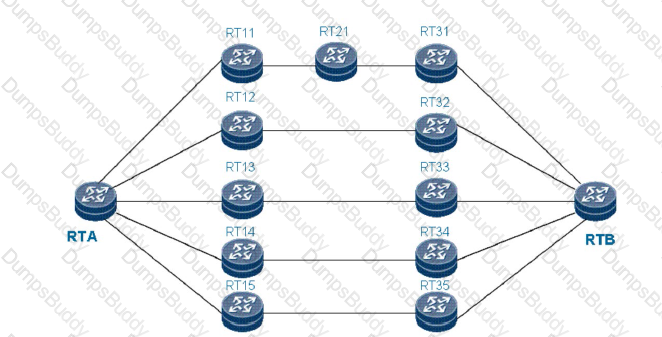
BFD for RSVP is a mechanism that uses BFD to check the connectivity of RSVP neighbors. As shown in the figure, TE FRR node protection is deployed to protect a node, the blue path is the primary LSP (RTA -> RTB -> RTC -> RTD -> RTE) and the red one is the bypass LSP (RTB -> RTF -> RTD). Which of the following statements about BFD for RSVP are true?
As shown in the figure, the bearer network is deployed in full mesh mode. For example, RTA uses the physical interface ATM 1/0/0. The interface is devised into ATM 10/0.2 connect to RTC and RTD, respectively . The GigabiteEthernet 2/0/0 and GigabitEthernet 3/0/0 interface are used to set up a trunk as the VRRP heartbeat cable. The UMG work in active/standby mode. Media interface connected to RTA and RTB belong to VLAN 10. VRRP is enable at the VLAN interface RTA is the master router. The interface is configured as follows:
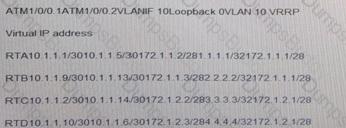
Which of the following RTA configurations are correct in VLAN 10?
A)
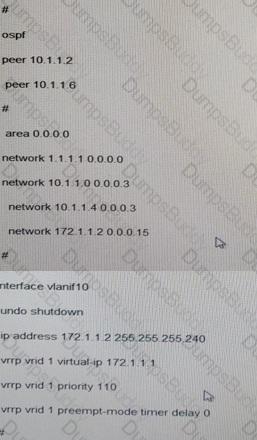
B)
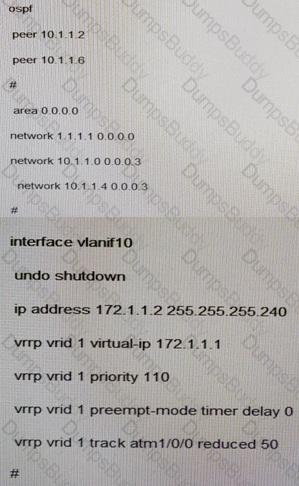
C)
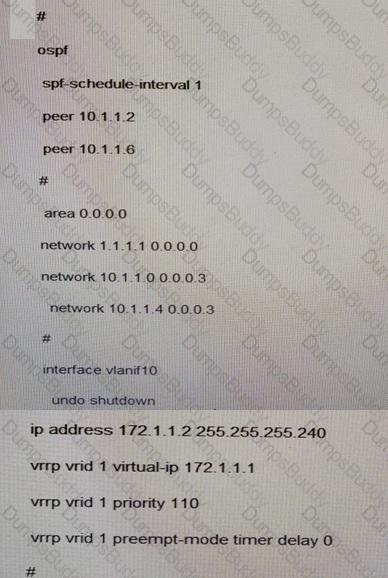
D)
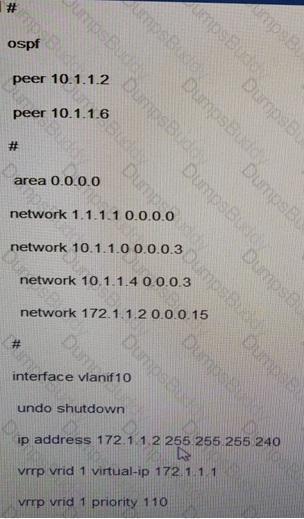
On the typical access network of a bearer network, a core network device connects to two
upstream CEs. CEs connect to PEs in a square shape. This access network must bear voice and
signaling services. A CE must be configured with two VPNs to separate the voice and signaling
services and ensure high security and QoS. The signaling service works in active/standby mode,
and the voice service works in load sharing mode. The VRRP must be enabled between the CEs to
terminate the signaling flow. If the network robustness is ensured and the network architecture is
rational, which of the following statements about the topological structure are true?
Refer to the exhibit.

As shown in the figure, VPN routes are transmitted between PE 1 and
PE 2 through BGP. OSPF process 100 runs on both PEs and CEs. The following BGP route exists on
PE 2.
[PE 2]display bgp vpnv4 vpn-instance red routing-table 43.1.1.0
BGP local router ID: 194.1.1.1
Local AS number: 100
Paths: 1 available, 1 best
BGP routing table entry information of 43.1.1.0/24:
Label information (Received/Applied): 15362/NULL
From: 1.1.1.1 (192.2.1.1)
Relay Nexthop: 0.0.0.0
Original nexthop: 1.1.1.1
Ext-Community: RT <100: 1>, <555: 0>, <0.0.0.0: 256>, <111.1.1.1: 0>
Convergence Priority: 0
AS-path Nil, origin incomplete, MED 7, localpref 100, pref-val 0, valid, intern
al, best, pre 255
Not advertised to any peer yet
If the domain ID configured on PE 2 is 555, which statement is true?
Exhibit.
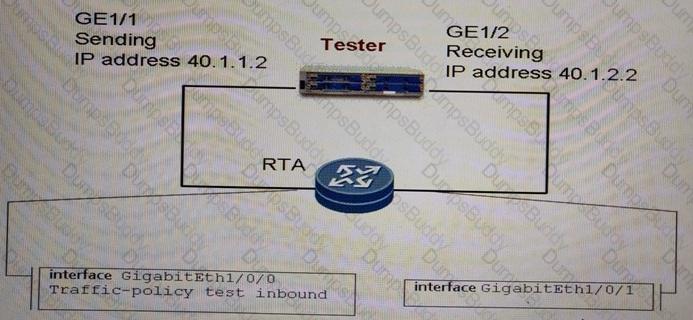
As shown in the figure, complex traffic classification is configured for RTA’s upstream GigabitEthernet 1/0/0. The QoS is configured as follows:
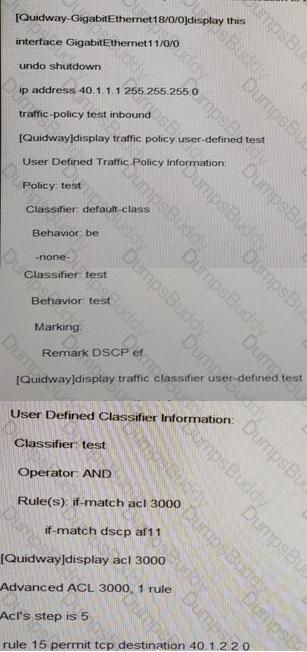
A tester sends TCP packets from GE 1/1 to GE 1/2 at 40 1.2.2 IF DSCP values of packets GE receives are not 46, what are the possible causes?